Case Study: CVAD Complications in Joseph Russo (CNA345 Module)
VerifiedAdded on 2023/04/21
|10
|3049
|251
Case Study
AI Summary
This case study examines the complications associated with a central venous access device (CVAD) in the case of Joseph Russo, a patient in the intensive care unit. The study highlights the risk of central line-associated bloodstream infection (CLABSI) and occlusion. It reviews literature, including cohort studies and randomized controlled trials, to identify risk factors, prevention strategies, and best practices. The assignment focuses on preventing bloodstream infections through needleless devices, proper skin antisepsis, and monitoring for skin integrity, while also addressing occlusion through the use of heparin-bound catheters and antithrombotic agents. The care plan developed emphasizes the importance of accurate evidence-based interventions, nursing care, and regular monitoring to improve patient outcomes, while considering the potential side effects of treatments like blood thinners. The study concludes with recommendations for incorporating best practices to minimize CVAD-related complications in intensive care settings.

Running head: CASE STUDY OF JOSEPH
Case study of Joseph
Name of the student:
Name of the university:
Author note:
Case study of Joseph
Name of the student:
Name of the university:
Author note:
Paraphrase This Document
Need a fresh take? Get an instant paraphrase of this document with our AI Paraphraser
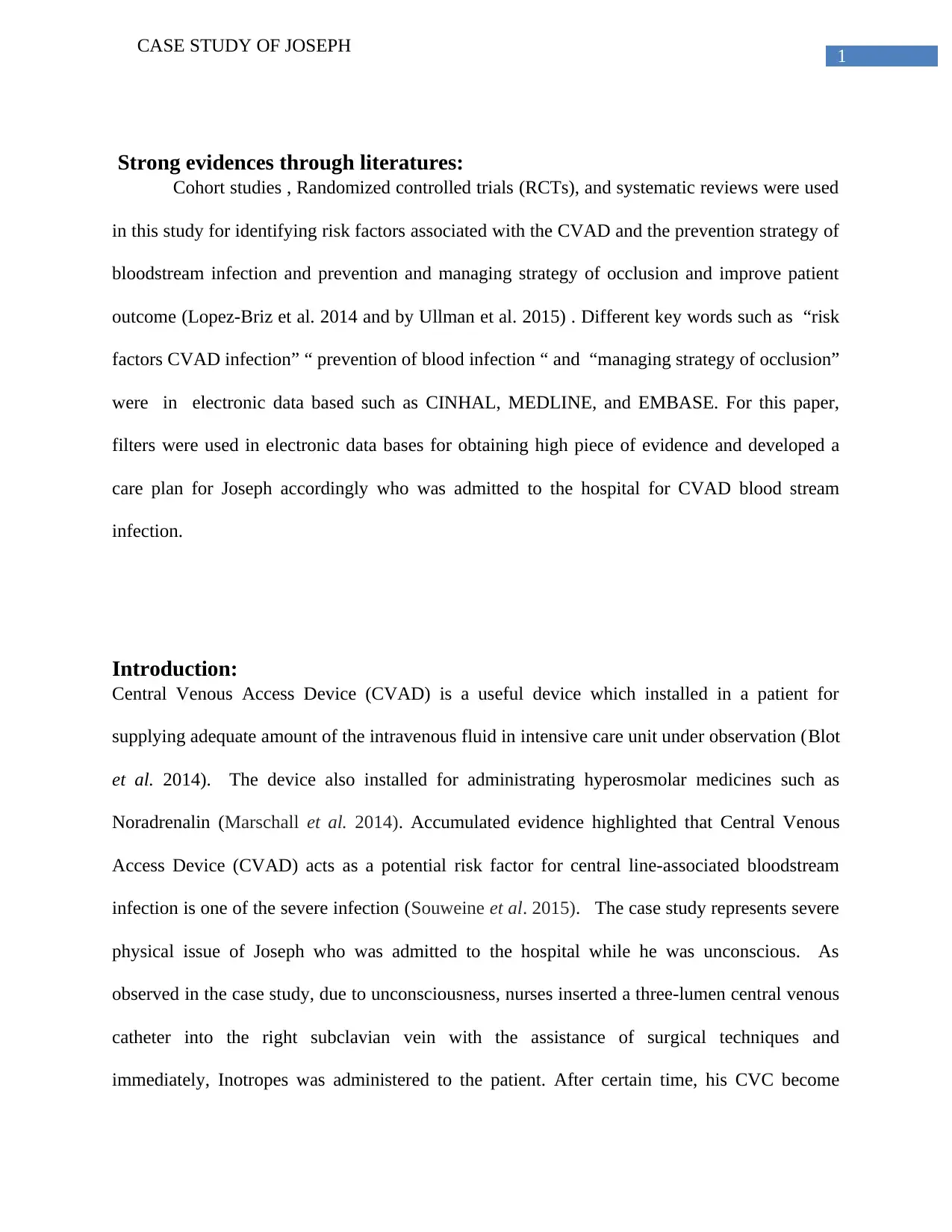
1
CASE STUDY OF JOSEPH
Strong evidences through literatures:
Cohort studies , Randomized controlled trials (RCTs), and systematic reviews were used
in this study for identifying risk factors associated with the CVAD and the prevention strategy of
bloodstream infection and prevention and managing strategy of occlusion and improve patient
outcome (Lopez-Briz et al. 2014 and by Ullman et al. 2015) . Different key words such as “risk
factors CVAD infection” “ prevention of blood infection “ and “managing strategy of occlusion”
were in electronic data based such as CINHAL, MEDLINE, and EMBASE. For this paper,
filters were used in electronic data bases for obtaining high piece of evidence and developed a
care plan for Joseph accordingly who was admitted to the hospital for CVAD blood stream
infection.
Introduction:
Central Venous Access Device (CVAD) is a useful device which installed in a patient for
supplying adequate amount of the intravenous fluid in intensive care unit under observation (Blot
et al. 2014). The device also installed for administrating hyperosmolar medicines such as
Noradrenalin (Marschall et al. 2014). Accumulated evidence highlighted that Central Venous
Access Device (CVAD) acts as a potential risk factor for central line-associated bloodstream
infection is one of the severe infection (Souweine et al. 2015). The case study represents severe
physical issue of Joseph who was admitted to the hospital while he was unconscious. As
observed in the case study, due to unconsciousness, nurses inserted a three-lumen central venous
catheter into the right subclavian vein with the assistance of surgical techniques and
immediately, Inotropes was administered to the patient. After certain time, his CVC become
CASE STUDY OF JOSEPH
Strong evidences through literatures:
Cohort studies , Randomized controlled trials (RCTs), and systematic reviews were used
in this study for identifying risk factors associated with the CVAD and the prevention strategy of
bloodstream infection and prevention and managing strategy of occlusion and improve patient
outcome (Lopez-Briz et al. 2014 and by Ullman et al. 2015) . Different key words such as “risk
factors CVAD infection” “ prevention of blood infection “ and “managing strategy of occlusion”
were in electronic data based such as CINHAL, MEDLINE, and EMBASE. For this paper,
filters were used in electronic data bases for obtaining high piece of evidence and developed a
care plan for Joseph accordingly who was admitted to the hospital for CVAD blood stream
infection.
Introduction:
Central Venous Access Device (CVAD) is a useful device which installed in a patient for
supplying adequate amount of the intravenous fluid in intensive care unit under observation (Blot
et al. 2014). The device also installed for administrating hyperosmolar medicines such as
Noradrenalin (Marschall et al. 2014). Accumulated evidence highlighted that Central Venous
Access Device (CVAD) acts as a potential risk factor for central line-associated bloodstream
infection is one of the severe infection (Souweine et al. 2015). The case study represents severe
physical issue of Joseph who was admitted to the hospital while he was unconscious. As
observed in the case study, due to unconsciousness, nurses inserted a three-lumen central venous
catheter into the right subclavian vein with the assistance of surgical techniques and
immediately, Inotropes was administered to the patient. After certain time, his CVC become
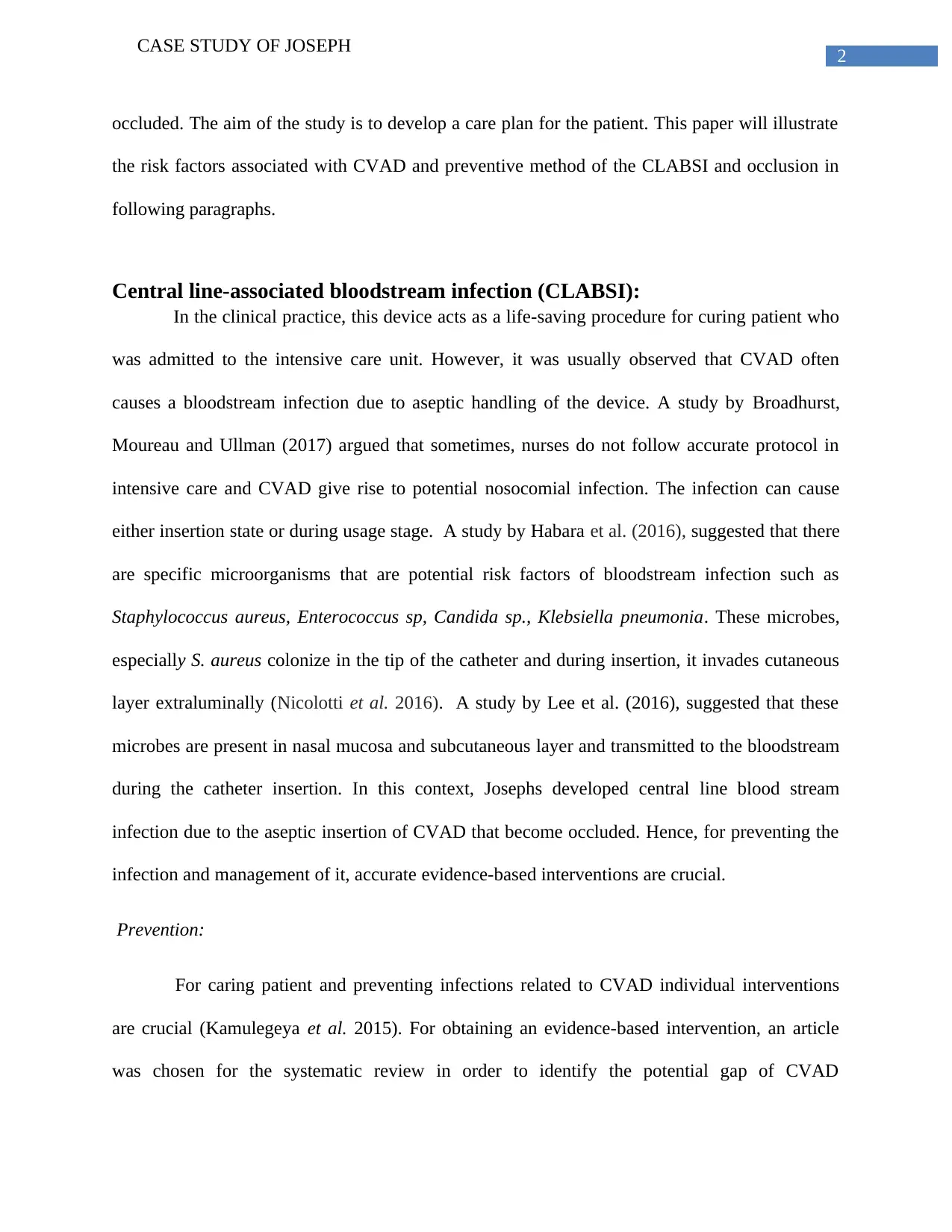
2
CASE STUDY OF JOSEPH
occluded. The aim of the study is to develop a care plan for the patient. This paper will illustrate
the risk factors associated with CVAD and preventive method of the CLABSI and occlusion in
following paragraphs.
Central line-associated bloodstream infection (CLABSI):
In the clinical practice, this device acts as a life-saving procedure for curing patient who
was admitted to the intensive care unit. However, it was usually observed that CVAD often
causes a bloodstream infection due to aseptic handling of the device. A study by Broadhurst,
Moureau and Ullman (2017) argued that sometimes, nurses do not follow accurate protocol in
intensive care and CVAD give rise to potential nosocomial infection. The infection can cause
either insertion state or during usage stage. A study by Habara et al. (2016), suggested that there
are specific microorganisms that are potential risk factors of bloodstream infection such as
Staphylococcus aureus, Enterococcus sp, Candida sp., Klebsiella pneumonia. These microbes,
especially S. aureus colonize in the tip of the catheter and during insertion, it invades cutaneous
layer extraluminally (Nicolotti et al. 2016). A study by Lee et al. (2016), suggested that these
microbes are present in nasal mucosa and subcutaneous layer and transmitted to the bloodstream
during the catheter insertion. In this context, Josephs developed central line blood stream
infection due to the aseptic insertion of CVAD that become occluded. Hence, for preventing the
infection and management of it, accurate evidence-based interventions are crucial.
Prevention:
For caring patient and preventing infections related to CVAD individual interventions
are crucial (Kamulegeya et al. 2015). For obtaining an evidence-based intervention, an article
was chosen for the systematic review in order to identify the potential gap of CVAD
CASE STUDY OF JOSEPH
occluded. The aim of the study is to develop a care plan for the patient. This paper will illustrate
the risk factors associated with CVAD and preventive method of the CLABSI and occlusion in
following paragraphs.
Central line-associated bloodstream infection (CLABSI):
In the clinical practice, this device acts as a life-saving procedure for curing patient who
was admitted to the intensive care unit. However, it was usually observed that CVAD often
causes a bloodstream infection due to aseptic handling of the device. A study by Broadhurst,
Moureau and Ullman (2017) argued that sometimes, nurses do not follow accurate protocol in
intensive care and CVAD give rise to potential nosocomial infection. The infection can cause
either insertion state or during usage stage. A study by Habara et al. (2016), suggested that there
are specific microorganisms that are potential risk factors of bloodstream infection such as
Staphylococcus aureus, Enterococcus sp, Candida sp., Klebsiella pneumonia. These microbes,
especially S. aureus colonize in the tip of the catheter and during insertion, it invades cutaneous
layer extraluminally (Nicolotti et al. 2016). A study by Lee et al. (2016), suggested that these
microbes are present in nasal mucosa and subcutaneous layer and transmitted to the bloodstream
during the catheter insertion. In this context, Josephs developed central line blood stream
infection due to the aseptic insertion of CVAD that become occluded. Hence, for preventing the
infection and management of it, accurate evidence-based interventions are crucial.
Prevention:
For caring patient and preventing infections related to CVAD individual interventions
are crucial (Kamulegeya et al. 2015). For obtaining an evidence-based intervention, an article
was chosen for the systematic review in order to identify the potential gap of CVAD
⊘ This is a preview!⊘
Do you want full access?
Subscribe today to unlock all pages.

Trusted by 1+ million students worldwide
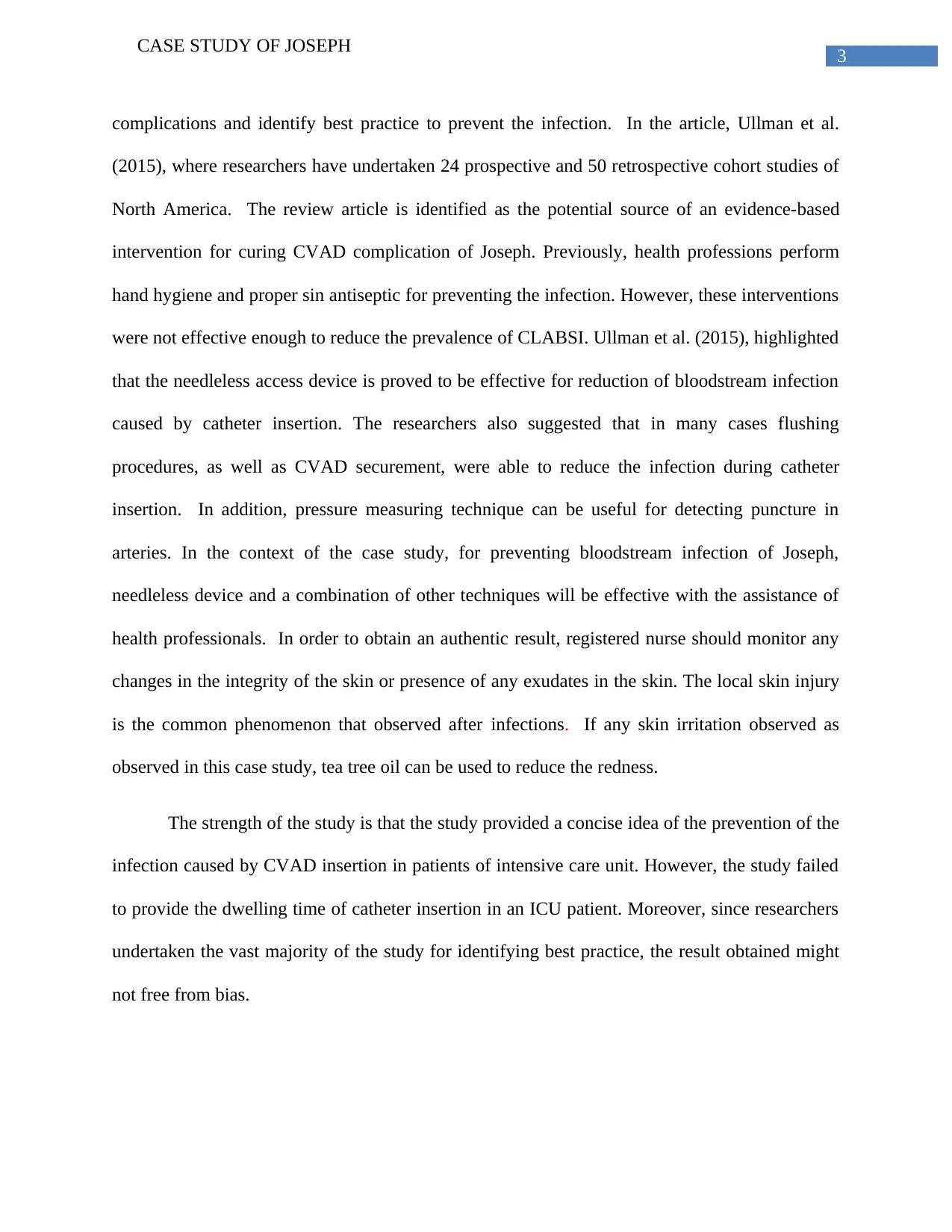
3
CASE STUDY OF JOSEPH
complications and identify best practice to prevent the infection. In the article, Ullman et al.
(2015), where researchers have undertaken 24 prospective and 50 retrospective cohort studies of
North America. The review article is identified as the potential source of an evidence-based
intervention for curing CVAD complication of Joseph. Previously, health professions perform
hand hygiene and proper sin antiseptic for preventing the infection. However, these interventions
were not effective enough to reduce the prevalence of CLABSI. Ullman et al. (2015), highlighted
that the needleless access device is proved to be effective for reduction of bloodstream infection
caused by catheter insertion. The researchers also suggested that in many cases flushing
procedures, as well as CVAD securement, were able to reduce the infection during catheter
insertion. In addition, pressure measuring technique can be useful for detecting puncture in
arteries. In the context of the case study, for preventing bloodstream infection of Joseph,
needleless device and a combination of other techniques will be effective with the assistance of
health professionals. In order to obtain an authentic result, registered nurse should monitor any
changes in the integrity of the skin or presence of any exudates in the skin. The local skin injury
is the common phenomenon that observed after infections. If any skin irritation observed as
observed in this case study, tea tree oil can be used to reduce the redness.
The strength of the study is that the study provided a concise idea of the prevention of the
infection caused by CVAD insertion in patients of intensive care unit. However, the study failed
to provide the dwelling time of catheter insertion in an ICU patient. Moreover, since researchers
undertaken the vast majority of the study for identifying best practice, the result obtained might
not free from bias.
CASE STUDY OF JOSEPH
complications and identify best practice to prevent the infection. In the article, Ullman et al.
(2015), where researchers have undertaken 24 prospective and 50 retrospective cohort studies of
North America. The review article is identified as the potential source of an evidence-based
intervention for curing CVAD complication of Joseph. Previously, health professions perform
hand hygiene and proper sin antiseptic for preventing the infection. However, these interventions
were not effective enough to reduce the prevalence of CLABSI. Ullman et al. (2015), highlighted
that the needleless access device is proved to be effective for reduction of bloodstream infection
caused by catheter insertion. The researchers also suggested that in many cases flushing
procedures, as well as CVAD securement, were able to reduce the infection during catheter
insertion. In addition, pressure measuring technique can be useful for detecting puncture in
arteries. In the context of the case study, for preventing bloodstream infection of Joseph,
needleless device and a combination of other techniques will be effective with the assistance of
health professionals. In order to obtain an authentic result, registered nurse should monitor any
changes in the integrity of the skin or presence of any exudates in the skin. The local skin injury
is the common phenomenon that observed after infections. If any skin irritation observed as
observed in this case study, tea tree oil can be used to reduce the redness.
The strength of the study is that the study provided a concise idea of the prevention of the
infection caused by CVAD insertion in patients of intensive care unit. However, the study failed
to provide the dwelling time of catheter insertion in an ICU patient. Moreover, since researchers
undertaken the vast majority of the study for identifying best practice, the result obtained might
not free from bias.
Paraphrase This Document
Need a fresh take? Get an instant paraphrase of this document with our AI Paraphraser
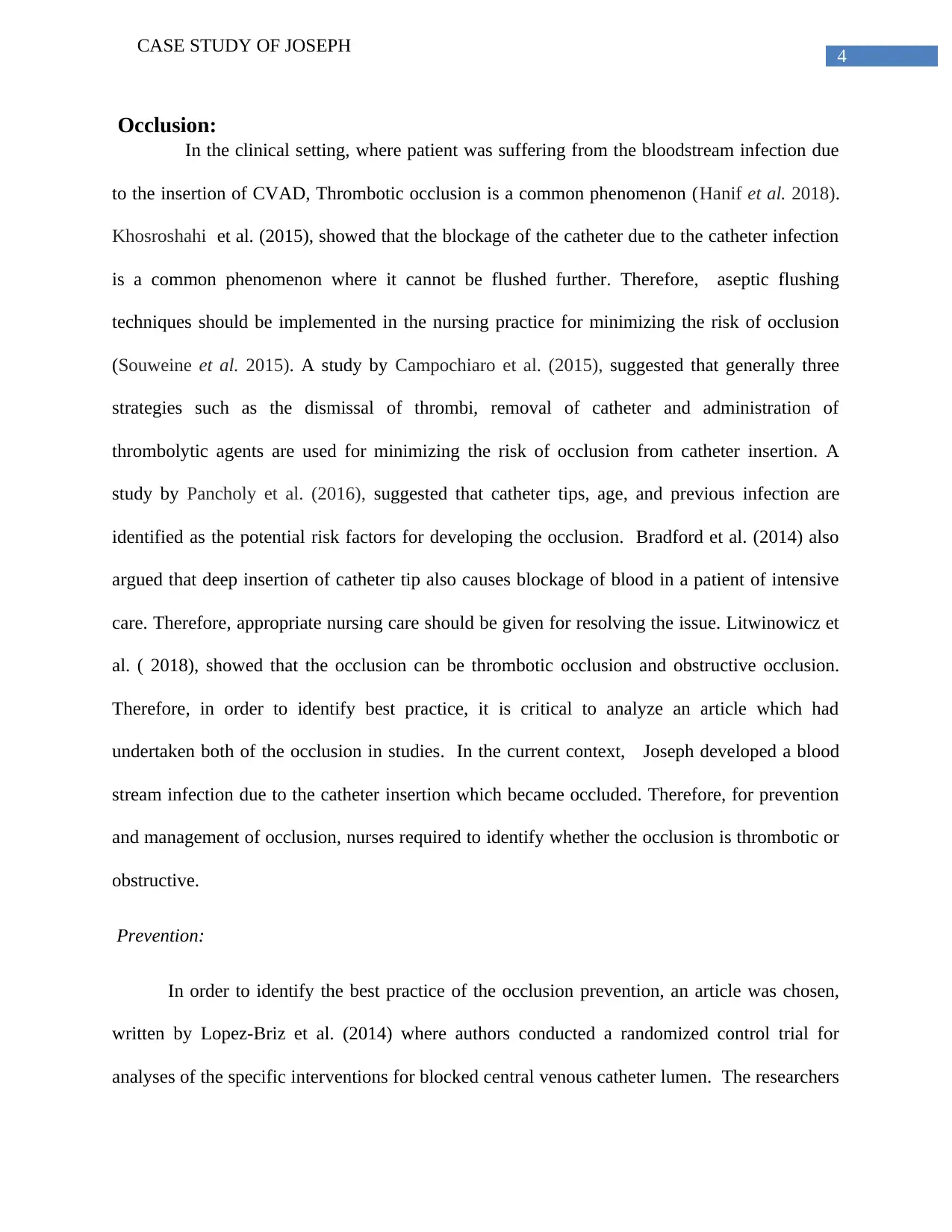
4
CASE STUDY OF JOSEPH
Occlusion:
In the clinical setting, where patient was suffering from the bloodstream infection due
to the insertion of CVAD, Thrombotic occlusion is a common phenomenon (Hanif et al. 2018).
Khosroshahi et al. (2015), showed that the blockage of the catheter due to the catheter infection
is a common phenomenon where it cannot be flushed further. Therefore, aseptic flushing
techniques should be implemented in the nursing practice for minimizing the risk of occlusion
(Souweine et al. 2015). A study by Campochiaro et al. (2015), suggested that generally three
strategies such as the dismissal of thrombi, removal of catheter and administration of
thrombolytic agents are used for minimizing the risk of occlusion from catheter insertion. A
study by Pancholy et al. (2016), suggested that catheter tips, age, and previous infection are
identified as the potential risk factors for developing the occlusion. Bradford et al. (2014) also
argued that deep insertion of catheter tip also causes blockage of blood in a patient of intensive
care. Therefore, appropriate nursing care should be given for resolving the issue. Litwinowicz et
al. ( 2018), showed that the occlusion can be thrombotic occlusion and obstructive occlusion.
Therefore, in order to identify best practice, it is critical to analyze an article which had
undertaken both of the occlusion in studies. In the current context, Joseph developed a blood
stream infection due to the catheter insertion which became occluded. Therefore, for prevention
and management of occlusion, nurses required to identify whether the occlusion is thrombotic or
obstructive.
Prevention:
In order to identify the best practice of the occlusion prevention, an article was chosen,
written by Lopez-Briz et al. (2014) where authors conducted a randomized control trial for
analyses of the specific interventions for blocked central venous catheter lumen. The researchers
CASE STUDY OF JOSEPH
Occlusion:
In the clinical setting, where patient was suffering from the bloodstream infection due
to the insertion of CVAD, Thrombotic occlusion is a common phenomenon (Hanif et al. 2018).
Khosroshahi et al. (2015), showed that the blockage of the catheter due to the catheter infection
is a common phenomenon where it cannot be flushed further. Therefore, aseptic flushing
techniques should be implemented in the nursing practice for minimizing the risk of occlusion
(Souweine et al. 2015). A study by Campochiaro et al. (2015), suggested that generally three
strategies such as the dismissal of thrombi, removal of catheter and administration of
thrombolytic agents are used for minimizing the risk of occlusion from catheter insertion. A
study by Pancholy et al. (2016), suggested that catheter tips, age, and previous infection are
identified as the potential risk factors for developing the occlusion. Bradford et al. (2014) also
argued that deep insertion of catheter tip also causes blockage of blood in a patient of intensive
care. Therefore, appropriate nursing care should be given for resolving the issue. Litwinowicz et
al. ( 2018), showed that the occlusion can be thrombotic occlusion and obstructive occlusion.
Therefore, in order to identify best practice, it is critical to analyze an article which had
undertaken both of the occlusion in studies. In the current context, Joseph developed a blood
stream infection due to the catheter insertion which became occluded. Therefore, for prevention
and management of occlusion, nurses required to identify whether the occlusion is thrombotic or
obstructive.
Prevention:
In order to identify the best practice of the occlusion prevention, an article was chosen,
written by Lopez-Briz et al. (2014) where authors conducted a randomized control trial for
analyses of the specific interventions for blocked central venous catheter lumen. The researchers
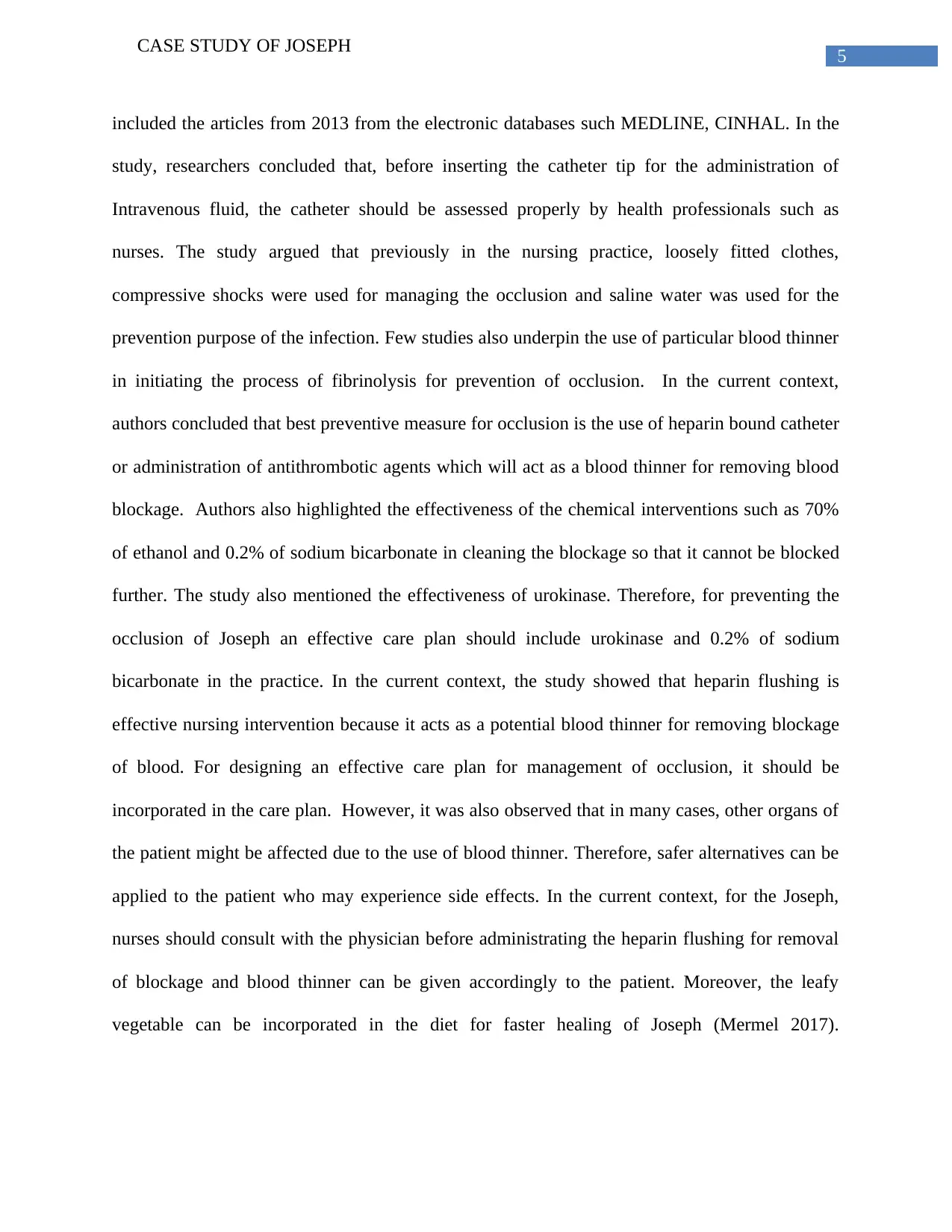
5
CASE STUDY OF JOSEPH
included the articles from 2013 from the electronic databases such MEDLINE, CINHAL. In the
study, researchers concluded that, before inserting the catheter tip for the administration of
Intravenous fluid, the catheter should be assessed properly by health professionals such as
nurses. The study argued that previously in the nursing practice, loosely fitted clothes,
compressive shocks were used for managing the occlusion and saline water was used for the
prevention purpose of the infection. Few studies also underpin the use of particular blood thinner
in initiating the process of fibrinolysis for prevention of occlusion. In the current context,
authors concluded that best preventive measure for occlusion is the use of heparin bound catheter
or administration of antithrombotic agents which will act as a blood thinner for removing blood
blockage. Authors also highlighted the effectiveness of the chemical interventions such as 70%
of ethanol and 0.2% of sodium bicarbonate in cleaning the blockage so that it cannot be blocked
further. The study also mentioned the effectiveness of urokinase. Therefore, for preventing the
occlusion of Joseph an effective care plan should include urokinase and 0.2% of sodium
bicarbonate in the practice. In the current context, the study showed that heparin flushing is
effective nursing intervention because it acts as a potential blood thinner for removing blockage
of blood. For designing an effective care plan for management of occlusion, it should be
incorporated in the care plan. However, it was also observed that in many cases, other organs of
the patient might be affected due to the use of blood thinner. Therefore, safer alternatives can be
applied to the patient who may experience side effects. In the current context, for the Joseph,
nurses should consult with the physician before administrating the heparin flushing for removal
of blockage and blood thinner can be given accordingly to the patient. Moreover, the leafy
vegetable can be incorporated in the diet for faster healing of Joseph (Mermel 2017).
CASE STUDY OF JOSEPH
included the articles from 2013 from the electronic databases such MEDLINE, CINHAL. In the
study, researchers concluded that, before inserting the catheter tip for the administration of
Intravenous fluid, the catheter should be assessed properly by health professionals such as
nurses. The study argued that previously in the nursing practice, loosely fitted clothes,
compressive shocks were used for managing the occlusion and saline water was used for the
prevention purpose of the infection. Few studies also underpin the use of particular blood thinner
in initiating the process of fibrinolysis for prevention of occlusion. In the current context,
authors concluded that best preventive measure for occlusion is the use of heparin bound catheter
or administration of antithrombotic agents which will act as a blood thinner for removing blood
blockage. Authors also highlighted the effectiveness of the chemical interventions such as 70%
of ethanol and 0.2% of sodium bicarbonate in cleaning the blockage so that it cannot be blocked
further. The study also mentioned the effectiveness of urokinase. Therefore, for preventing the
occlusion of Joseph an effective care plan should include urokinase and 0.2% of sodium
bicarbonate in the practice. In the current context, the study showed that heparin flushing is
effective nursing intervention because it acts as a potential blood thinner for removing blockage
of blood. For designing an effective care plan for management of occlusion, it should be
incorporated in the care plan. However, it was also observed that in many cases, other organs of
the patient might be affected due to the use of blood thinner. Therefore, safer alternatives can be
applied to the patient who may experience side effects. In the current context, for the Joseph,
nurses should consult with the physician before administrating the heparin flushing for removal
of blockage and blood thinner can be given accordingly to the patient. Moreover, the leafy
vegetable can be incorporated in the diet for faster healing of Joseph (Mermel 2017).
⊘ This is a preview!⊘
Do you want full access?
Subscribe today to unlock all pages.

Trusted by 1+ million students worldwide
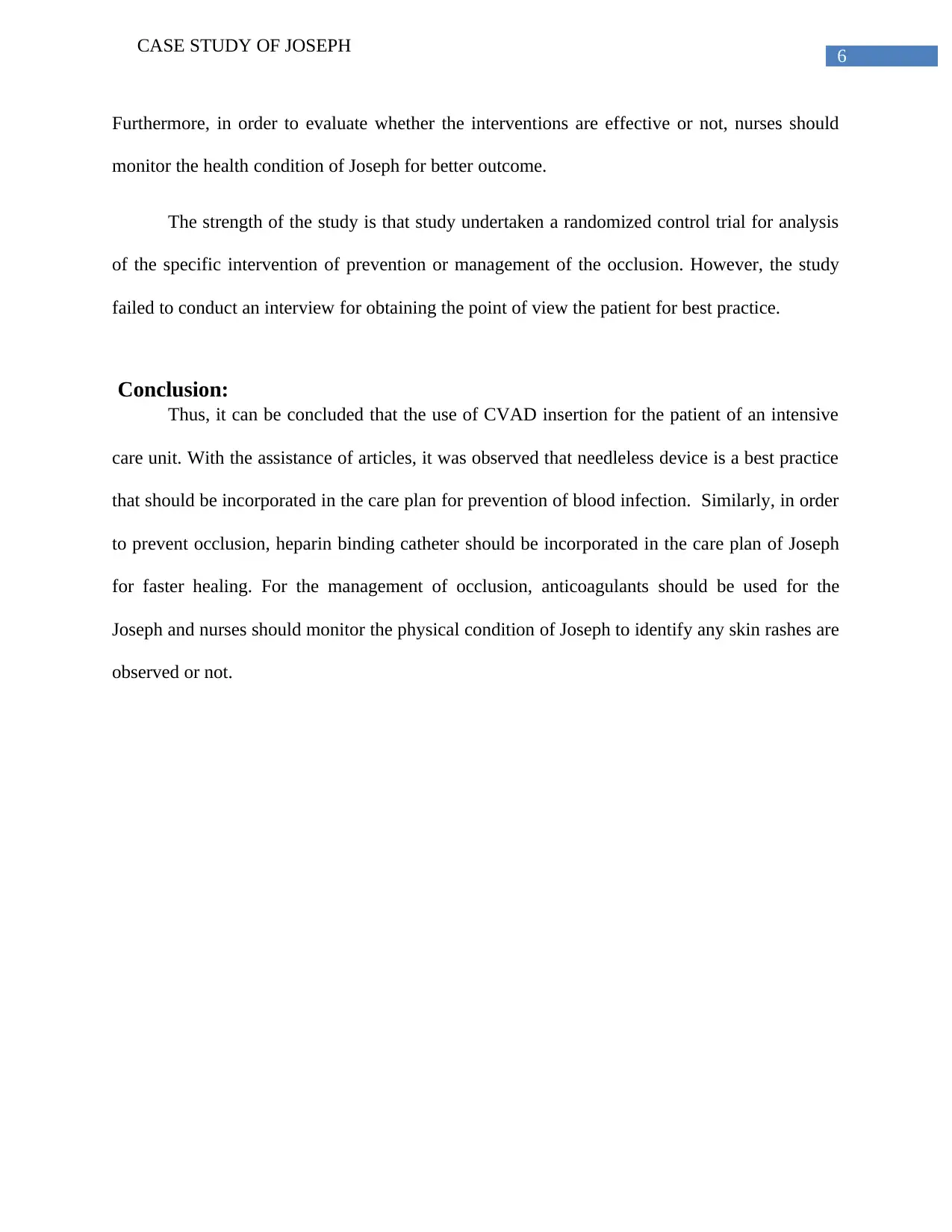
6
CASE STUDY OF JOSEPH
Furthermore, in order to evaluate whether the interventions are effective or not, nurses should
monitor the health condition of Joseph for better outcome.
The strength of the study is that study undertaken a randomized control trial for analysis
of the specific intervention of prevention or management of the occlusion. However, the study
failed to conduct an interview for obtaining the point of view the patient for best practice.
Conclusion:
Thus, it can be concluded that the use of CVAD insertion for the patient of an intensive
care unit. With the assistance of articles, it was observed that needleless device is a best practice
that should be incorporated in the care plan for prevention of blood infection. Similarly, in order
to prevent occlusion, heparin binding catheter should be incorporated in the care plan of Joseph
for faster healing. For the management of occlusion, anticoagulants should be used for the
Joseph and nurses should monitor the physical condition of Joseph to identify any skin rashes are
observed or not.
CASE STUDY OF JOSEPH
Furthermore, in order to evaluate whether the interventions are effective or not, nurses should
monitor the health condition of Joseph for better outcome.
The strength of the study is that study undertaken a randomized control trial for analysis
of the specific intervention of prevention or management of the occlusion. However, the study
failed to conduct an interview for obtaining the point of view the patient for best practice.
Conclusion:
Thus, it can be concluded that the use of CVAD insertion for the patient of an intensive
care unit. With the assistance of articles, it was observed that needleless device is a best practice
that should be incorporated in the care plan for prevention of blood infection. Similarly, in order
to prevent occlusion, heparin binding catheter should be incorporated in the care plan of Joseph
for faster healing. For the management of occlusion, anticoagulants should be used for the
Joseph and nurses should monitor the physical condition of Joseph to identify any skin rashes are
observed or not.
Paraphrase This Document
Need a fresh take? Get an instant paraphrase of this document with our AI Paraphraser
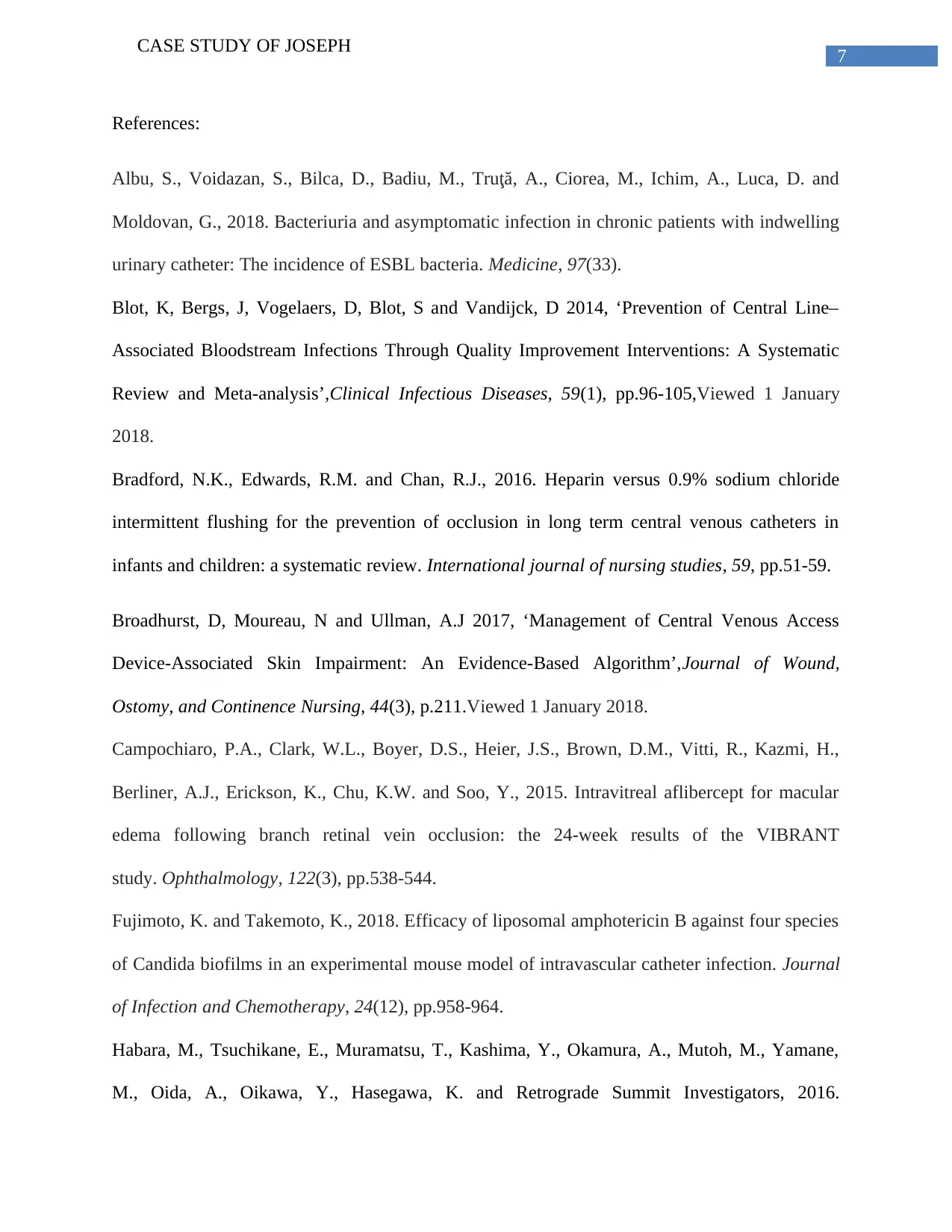
7
CASE STUDY OF JOSEPH
References:
Albu, S., Voidazan, S., Bilca, D., Badiu, M., Truţă, A., Ciorea, M., Ichim, A., Luca, D. and
Moldovan, G., 2018. Bacteriuria and asymptomatic infection in chronic patients with indwelling
urinary catheter: The incidence of ESBL bacteria. Medicine, 97(33).
Blot, K, Bergs, J, Vogelaers, D, Blot, S and Vandijck, D 2014, ‘Prevention of Central Line–
Associated Bloodstream Infections Through Quality Improvement Interventions: A Systematic
Review and Meta-analysis’,Clinical Infectious Diseases, 59(1), pp.96-105,Viewed 1 January
2018.
Bradford, N.K., Edwards, R.M. and Chan, R.J., 2016. Heparin versus 0.9% sodium chloride
intermittent flushing for the prevention of occlusion in long term central venous catheters in
infants and children: a systematic review. International journal of nursing studies, 59, pp.51-59.
Broadhurst, D, Moureau, N and Ullman, A.J 2017, ‘Management of Central Venous Access
Device-Associated Skin Impairment: An Evidence-Based Algorithm’,Journal of Wound,
Ostomy, and Continence Nursing, 44(3), p.211.Viewed 1 January 2018.
Campochiaro, P.A., Clark, W.L., Boyer, D.S., Heier, J.S., Brown, D.M., Vitti, R., Kazmi, H.,
Berliner, A.J., Erickson, K., Chu, K.W. and Soo, Y., 2015. Intravitreal aflibercept for macular
edema following branch retinal vein occlusion: the 24-week results of the VIBRANT
study. Ophthalmology, 122(3), pp.538-544.
Fujimoto, K. and Takemoto, K., 2018. Efficacy of liposomal amphotericin B against four species
of Candida biofilms in an experimental mouse model of intravascular catheter infection. Journal
of Infection and Chemotherapy, 24(12), pp.958-964.
Habara, M., Tsuchikane, E., Muramatsu, T., Kashima, Y., Okamura, A., Mutoh, M., Yamane,
M., Oida, A., Oikawa, Y., Hasegawa, K. and Retrograde Summit Investigators, 2016.
CASE STUDY OF JOSEPH
References:
Albu, S., Voidazan, S., Bilca, D., Badiu, M., Truţă, A., Ciorea, M., Ichim, A., Luca, D. and
Moldovan, G., 2018. Bacteriuria and asymptomatic infection in chronic patients with indwelling
urinary catheter: The incidence of ESBL bacteria. Medicine, 97(33).
Blot, K, Bergs, J, Vogelaers, D, Blot, S and Vandijck, D 2014, ‘Prevention of Central Line–
Associated Bloodstream Infections Through Quality Improvement Interventions: A Systematic
Review and Meta-analysis’,Clinical Infectious Diseases, 59(1), pp.96-105,Viewed 1 January
2018.
Bradford, N.K., Edwards, R.M. and Chan, R.J., 2016. Heparin versus 0.9% sodium chloride
intermittent flushing for the prevention of occlusion in long term central venous catheters in
infants and children: a systematic review. International journal of nursing studies, 59, pp.51-59.
Broadhurst, D, Moureau, N and Ullman, A.J 2017, ‘Management of Central Venous Access
Device-Associated Skin Impairment: An Evidence-Based Algorithm’,Journal of Wound,
Ostomy, and Continence Nursing, 44(3), p.211.Viewed 1 January 2018.
Campochiaro, P.A., Clark, W.L., Boyer, D.S., Heier, J.S., Brown, D.M., Vitti, R., Kazmi, H.,
Berliner, A.J., Erickson, K., Chu, K.W. and Soo, Y., 2015. Intravitreal aflibercept for macular
edema following branch retinal vein occlusion: the 24-week results of the VIBRANT
study. Ophthalmology, 122(3), pp.538-544.
Fujimoto, K. and Takemoto, K., 2018. Efficacy of liposomal amphotericin B against four species
of Candida biofilms in an experimental mouse model of intravascular catheter infection. Journal
of Infection and Chemotherapy, 24(12), pp.958-964.
Habara, M., Tsuchikane, E., Muramatsu, T., Kashima, Y., Okamura, A., Mutoh, M., Yamane,
M., Oida, A., Oikawa, Y., Hasegawa, K. and Retrograde Summit Investigators, 2016.
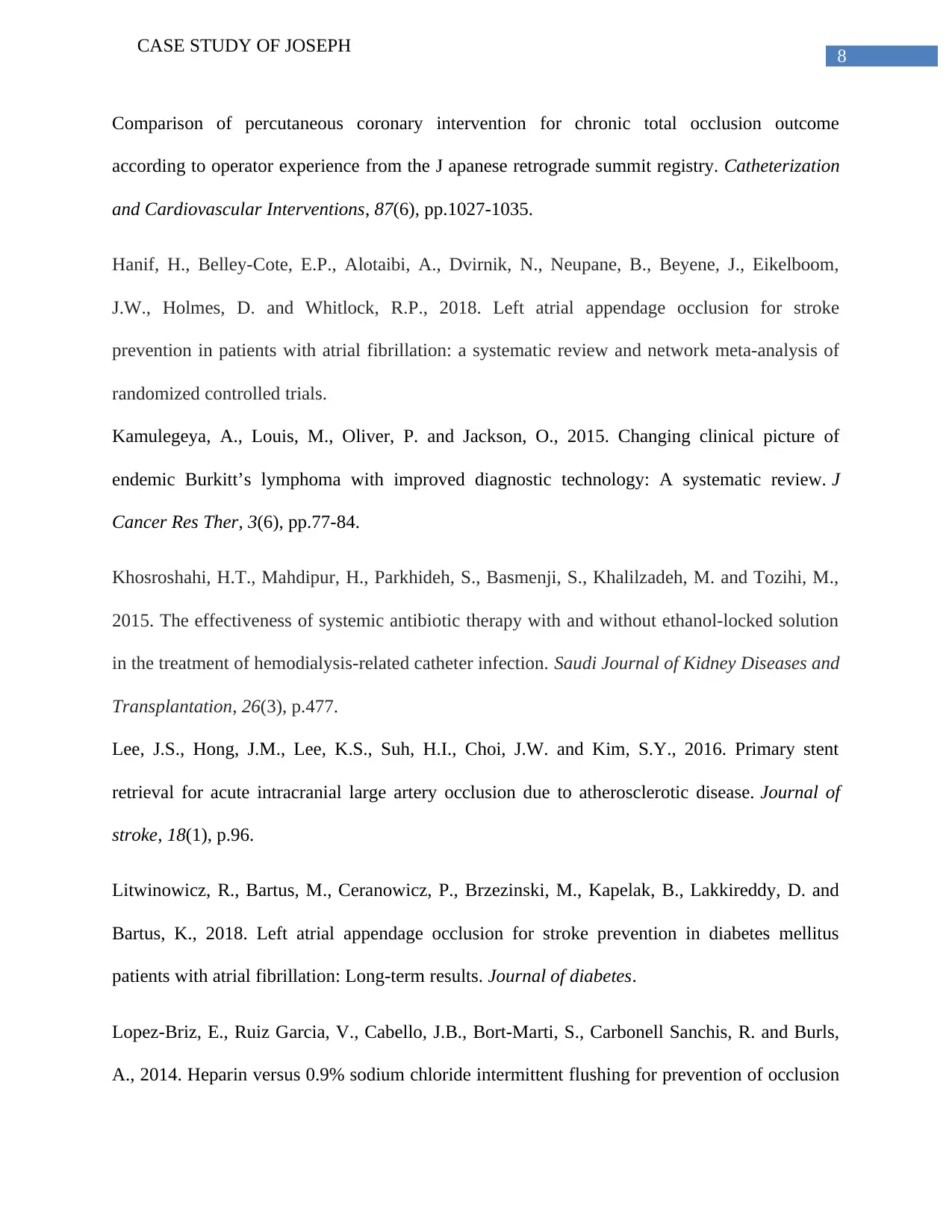
8
CASE STUDY OF JOSEPH
Comparison of percutaneous coronary intervention for chronic total occlusion outcome
according to operator experience from the J apanese retrograde summit registry. Catheterization
and Cardiovascular Interventions, 87(6), pp.1027-1035.
Hanif, H., Belley-Cote, E.P., Alotaibi, A., Dvirnik, N., Neupane, B., Beyene, J., Eikelboom,
J.W., Holmes, D. and Whitlock, R.P., 2018. Left atrial appendage occlusion for stroke
prevention in patients with atrial fibrillation: a systematic review and network meta-analysis of
randomized controlled trials.
Kamulegeya, A., Louis, M., Oliver, P. and Jackson, O., 2015. Changing clinical picture of
endemic Burkitt’s lymphoma with improved diagnostic technology: A systematic review. J
Cancer Res Ther, 3(6), pp.77-84.
Khosroshahi, H.T., Mahdipur, H., Parkhideh, S., Basmenji, S., Khalilzadeh, M. and Tozihi, M.,
2015. The effectiveness of systemic antibiotic therapy with and without ethanol-locked solution
in the treatment of hemodialysis-related catheter infection. Saudi Journal of Kidney Diseases and
Transplantation, 26(3), p.477.
Lee, J.S., Hong, J.M., Lee, K.S., Suh, H.I., Choi, J.W. and Kim, S.Y., 2016. Primary stent
retrieval for acute intracranial large artery occlusion due to atherosclerotic disease. Journal of
stroke, 18(1), p.96.
Litwinowicz, R., Bartus, M., Ceranowicz, P., Brzezinski, M., Kapelak, B., Lakkireddy, D. and
Bartus, K., 2018. Left atrial appendage occlusion for stroke prevention in diabetes mellitus
patients with atrial fibrillation: Long‐term results. Journal of diabetes.
Lopez-Briz, E., Ruiz Garcia, V., Cabello, J.B., Bort-Marti, S., Carbonell Sanchis, R. and Burls,
A., 2014. Heparin versus 0.9% sodium chloride intermittent flushing for prevention of occlusion
CASE STUDY OF JOSEPH
Comparison of percutaneous coronary intervention for chronic total occlusion outcome
according to operator experience from the J apanese retrograde summit registry. Catheterization
and Cardiovascular Interventions, 87(6), pp.1027-1035.
Hanif, H., Belley-Cote, E.P., Alotaibi, A., Dvirnik, N., Neupane, B., Beyene, J., Eikelboom,
J.W., Holmes, D. and Whitlock, R.P., 2018. Left atrial appendage occlusion for stroke
prevention in patients with atrial fibrillation: a systematic review and network meta-analysis of
randomized controlled trials.
Kamulegeya, A., Louis, M., Oliver, P. and Jackson, O., 2015. Changing clinical picture of
endemic Burkitt’s lymphoma with improved diagnostic technology: A systematic review. J
Cancer Res Ther, 3(6), pp.77-84.
Khosroshahi, H.T., Mahdipur, H., Parkhideh, S., Basmenji, S., Khalilzadeh, M. and Tozihi, M.,
2015. The effectiveness of systemic antibiotic therapy with and without ethanol-locked solution
in the treatment of hemodialysis-related catheter infection. Saudi Journal of Kidney Diseases and
Transplantation, 26(3), p.477.
Lee, J.S., Hong, J.M., Lee, K.S., Suh, H.I., Choi, J.W. and Kim, S.Y., 2016. Primary stent
retrieval for acute intracranial large artery occlusion due to atherosclerotic disease. Journal of
stroke, 18(1), p.96.
Litwinowicz, R., Bartus, M., Ceranowicz, P., Brzezinski, M., Kapelak, B., Lakkireddy, D. and
Bartus, K., 2018. Left atrial appendage occlusion for stroke prevention in diabetes mellitus
patients with atrial fibrillation: Long‐term results. Journal of diabetes.
Lopez-Briz, E., Ruiz Garcia, V., Cabello, J.B., Bort-Marti, S., Carbonell Sanchis, R. and Burls,
A., 2014. Heparin versus 0.9% sodium chloride intermittent flushing for prevention of occlusion
⊘ This is a preview!⊘
Do you want full access?
Subscribe today to unlock all pages.

Trusted by 1+ million students worldwide
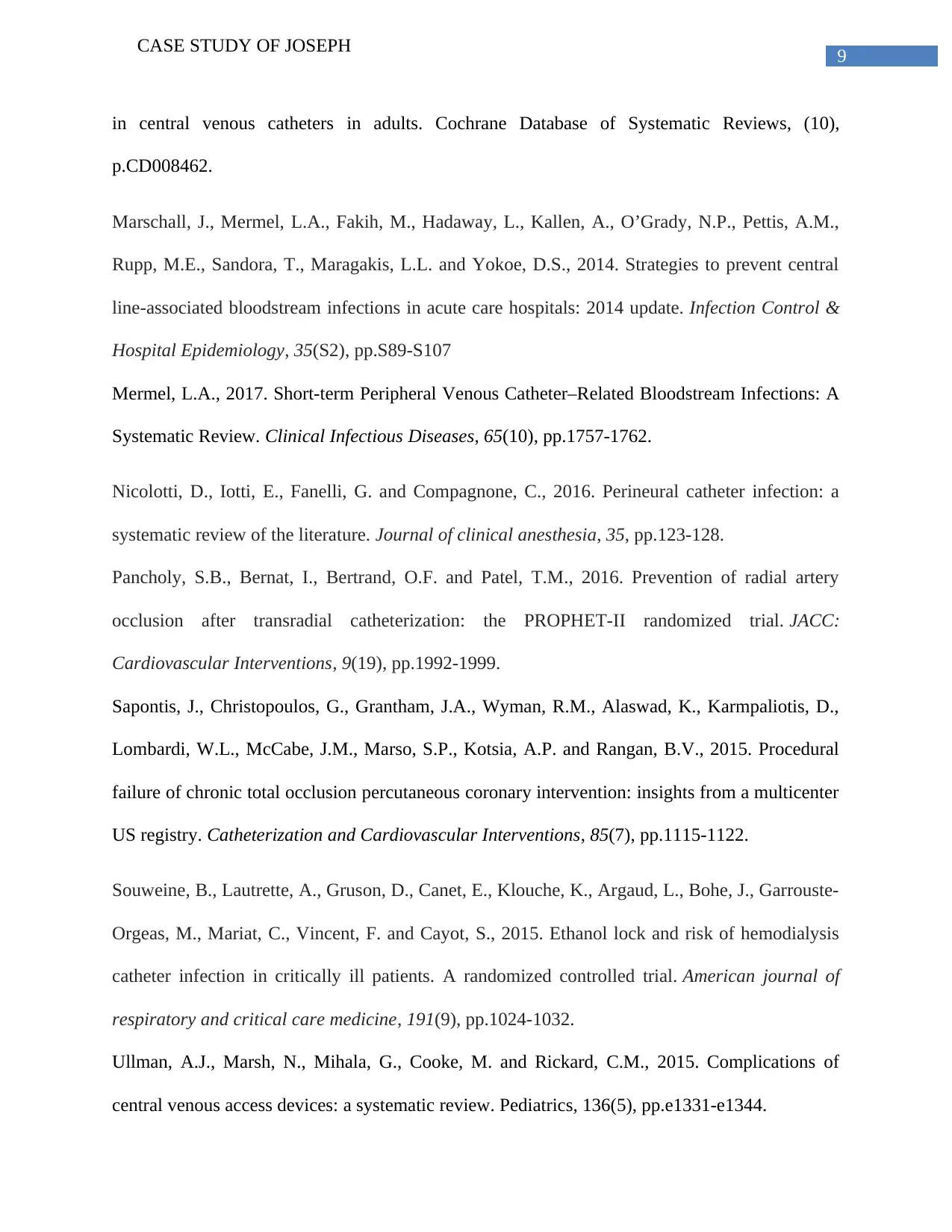
9
CASE STUDY OF JOSEPH
in central venous catheters in adults. Cochrane Database of Systematic Reviews, (10),
p.CD008462.
Marschall, J., Mermel, L.A., Fakih, M., Hadaway, L., Kallen, A., O’Grady, N.P., Pettis, A.M.,
Rupp, M.E., Sandora, T., Maragakis, L.L. and Yokoe, D.S., 2014. Strategies to prevent central
line-associated bloodstream infections in acute care hospitals: 2014 update. Infection Control &
Hospital Epidemiology, 35(S2), pp.S89-S107
Mermel, L.A., 2017. Short-term Peripheral Venous Catheter–Related Bloodstream Infections: A
Systematic Review. Clinical Infectious Diseases, 65(10), pp.1757-1762.
Nicolotti, D., Iotti, E., Fanelli, G. and Compagnone, C., 2016. Perineural catheter infection: a
systematic review of the literature. Journal of clinical anesthesia, 35, pp.123-128.
Pancholy, S.B., Bernat, I., Bertrand, O.F. and Patel, T.M., 2016. Prevention of radial artery
occlusion after transradial catheterization: the PROPHET-II randomized trial. JACC:
Cardiovascular Interventions, 9(19), pp.1992-1999.
Sapontis, J., Christopoulos, G., Grantham, J.A., Wyman, R.M., Alaswad, K., Karmpaliotis, D.,
Lombardi, W.L., McCabe, J.M., Marso, S.P., Kotsia, A.P. and Rangan, B.V., 2015. Procedural
failure of chronic total occlusion percutaneous coronary intervention: insights from a multicenter
US registry. Catheterization and Cardiovascular Interventions, 85(7), pp.1115-1122.
Souweine, B., Lautrette, A., Gruson, D., Canet, E., Klouche, K., Argaud, L., Bohe, J., Garrouste-
Orgeas, M., Mariat, C., Vincent, F. and Cayot, S., 2015. Ethanol lock and risk of hemodialysis
catheter infection in critically ill patients. A randomized controlled trial. American journal of
respiratory and critical care medicine, 191(9), pp.1024-1032.
Ullman, A.J., Marsh, N., Mihala, G., Cooke, M. and Rickard, C.M., 2015. Complications of
central venous access devices: a systematic review. Pediatrics, 136(5), pp.e1331-e1344.
CASE STUDY OF JOSEPH
in central venous catheters in adults. Cochrane Database of Systematic Reviews, (10),
p.CD008462.
Marschall, J., Mermel, L.A., Fakih, M., Hadaway, L., Kallen, A., O’Grady, N.P., Pettis, A.M.,
Rupp, M.E., Sandora, T., Maragakis, L.L. and Yokoe, D.S., 2014. Strategies to prevent central
line-associated bloodstream infections in acute care hospitals: 2014 update. Infection Control &
Hospital Epidemiology, 35(S2), pp.S89-S107
Mermel, L.A., 2017. Short-term Peripheral Venous Catheter–Related Bloodstream Infections: A
Systematic Review. Clinical Infectious Diseases, 65(10), pp.1757-1762.
Nicolotti, D., Iotti, E., Fanelli, G. and Compagnone, C., 2016. Perineural catheter infection: a
systematic review of the literature. Journal of clinical anesthesia, 35, pp.123-128.
Pancholy, S.B., Bernat, I., Bertrand, O.F. and Patel, T.M., 2016. Prevention of radial artery
occlusion after transradial catheterization: the PROPHET-II randomized trial. JACC:
Cardiovascular Interventions, 9(19), pp.1992-1999.
Sapontis, J., Christopoulos, G., Grantham, J.A., Wyman, R.M., Alaswad, K., Karmpaliotis, D.,
Lombardi, W.L., McCabe, J.M., Marso, S.P., Kotsia, A.P. and Rangan, B.V., 2015. Procedural
failure of chronic total occlusion percutaneous coronary intervention: insights from a multicenter
US registry. Catheterization and Cardiovascular Interventions, 85(7), pp.1115-1122.
Souweine, B., Lautrette, A., Gruson, D., Canet, E., Klouche, K., Argaud, L., Bohe, J., Garrouste-
Orgeas, M., Mariat, C., Vincent, F. and Cayot, S., 2015. Ethanol lock and risk of hemodialysis
catheter infection in critically ill patients. A randomized controlled trial. American journal of
respiratory and critical care medicine, 191(9), pp.1024-1032.
Ullman, A.J., Marsh, N., Mihala, G., Cooke, M. and Rickard, C.M., 2015. Complications of
central venous access devices: a systematic review. Pediatrics, 136(5), pp.e1331-e1344.
1 out of 10
Related Documents
Your All-in-One AI-Powered Toolkit for Academic Success.
+13062052269
info@desklib.com
Available 24*7 on WhatsApp / Email
![[object Object]](/_next/static/media/star-bottom.7253800d.svg)
Unlock your academic potential
Copyright © 2020–2025 A2Z Services. All Rights Reserved. Developed and managed by ZUCOL.





